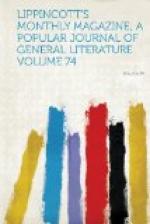the grass at the base of an ivied fragment, measure
the girth of the great stumps of the central columns,
half smothered in soft creepers, and think how strange
it is that in this quiet hollow, in the midst of lonely
hills, so exquisite and elaborate a work of art should
have arisen. It is but an hour’s walk to
another great ruin, which has held together more completely.
There the central tower stands erect to half its altitude,
and the round arches and massive pillars of the nave
make a perfect vista on the unencumbered turf.
You get an impression that when Catholic England was
in her prime great abbeys were as thick as milestones.
By native amateurs, even now, the region is called
“wild,” though to American eyes it seems
thoroughly suburban in its smoothness and finish.
There is a noiseless little railway running through
the valley, and there is an ancient little town at
the abbey gates—a town, indeed, with no
great din of vehicles, but with goodly brick houses,
with a dozen “publics,” with tidy, whitewashed
cottages, and with little girls, as I have said, bobbing
courtesies in the street. But even now, if one
had wound one’s way into the valley by the railroad,
it would be rather a surprise to find a small ornamental
cathedral in a spot on the whole so natural and pastoral.
How impressive then must the beautiful church have
been in the days of its prosperity, when the pilgrim
came down to it from the grassy hillside and its bells
made the stillness sensible! The abbey was in
those days a great affair: as my companion said,
it sprawled all over the place. As you walk away
from it you think you have got to the end of its traces,
but you encounter them still in the shape of a rugged
outhouse grand with an Early-English arch, or an ancient
well hidden in a kind of sculptured cavern. It
is noticeable that even if you are a traveller from
a land where there are no Early-English—and
indeed few Late-English—arches, and where
the well-covers are, at their hoariest, of fresh-looking
shingles, you grow used with little delay to all this
antiquity. Anything very old seems extremely natural:
there is nothing we accept so implicitly as the past.
It is not too much to say that after spending twenty-four
hours in a house that is six hundred years old, you
seem yourself to have lived in it for six hundred years.
You seem yourself to have hollowed the flags with
your tread and to have polished the oak with your
touch. You walk along the little stone gallery
where the monks used to pace, looking out of the Gothic
window-places at their beautiful church, and you pause
at the big round, rugged doorway that admits you to
what is now the drawing-room. The massive step
by which you ascend to the threshold is a trifle crooked,
as it should be: the lintels are cracked and
worn by the myriad-fingered years. This strikes
your casual glance. You look up and down the
miniature cloister before you pass in: it seems
wonderfully old and queer. Then you turn into




